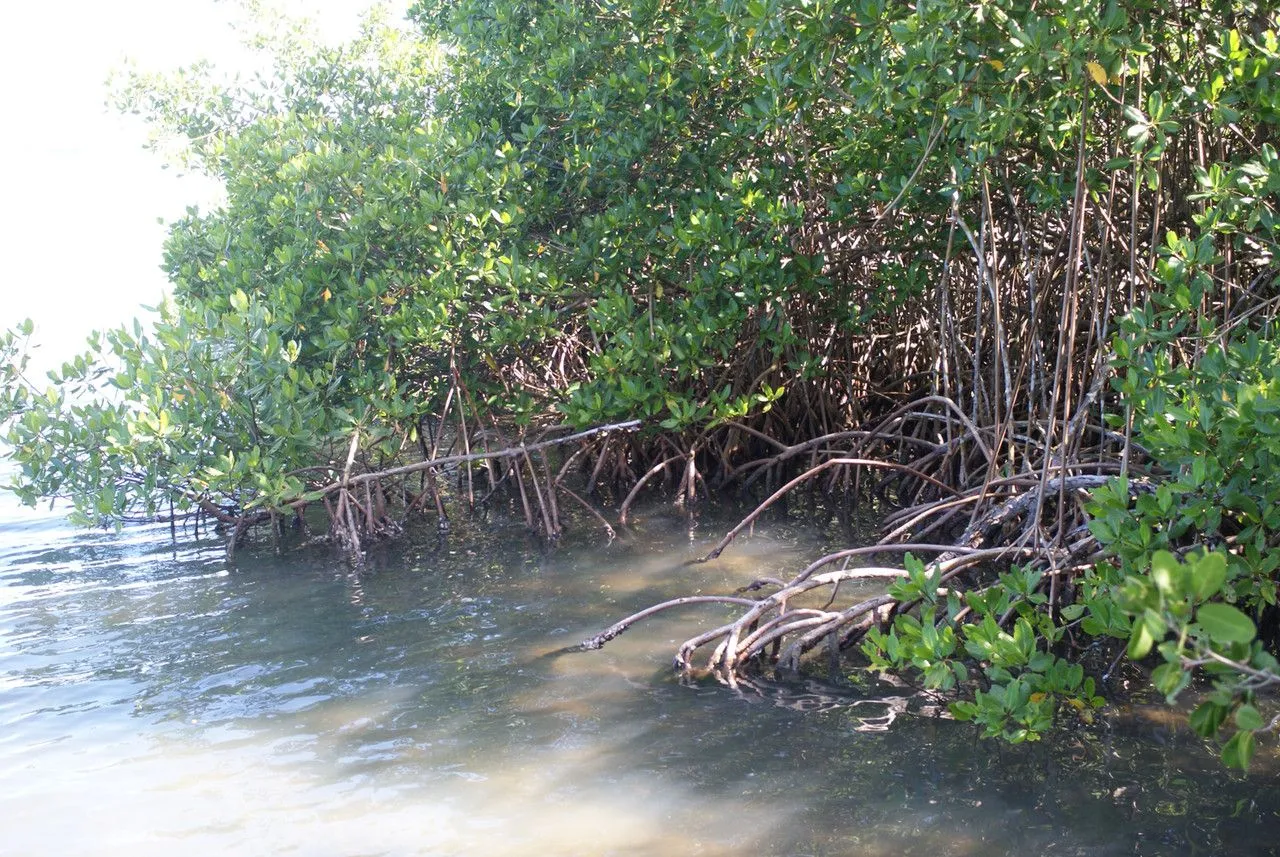
Author: L.
Bibliography: Sp. Pl.: 443 (1753)
Year: 1753
Status: accepted
Rank: species
Genus: Rhizophora
Vegetable: False
Observations: W. Trop. Africa to Angola, S. Florida to Trop. America
The Red Mangrove, known scientifically as Rhizophora mangle, stands as a vital species within the family Rhizophoraceae. This remarkable plant, first described in 1753 by L., has a distribution that stretches from Western Tropical Africa to Angola, and from Southern Florida to Tropical America. Its presence is a hallmark of coastal ecosystems in these regions, where it plays a critical role in maintaining environmental stability and supporting diverse wildlife.
Characterized by its distinctive above-ground root structures, commonly referred to as “stilt roots,” the Red Mangrove plants are adept at anchoring themselves in the soft, unstable substrates of intertidal zones. These roots not only provide stability to the plants themselves but also serve to reduce coastal erosion by trapping sediments and buffering wave action, which helps protect shorelines from storm surges.
The morphological features of Rhizophora mangle enable it to thrive in saline environments—an adaptation of great ecological significance. The leaves are typically broad and waxy, designed to minimize water loss and exclude salt, while its propagules (seedlings) can float, allowing for widespread dispersal over water before rooting in suitable locations.
Ecologically, Red Mangroves are indispensable to the health of coastal habitats. They create intricate and impenetrable networks of roots and branches that offer refuge and breeding grounds for a myriad of marine and terrestrial organisms. Fish, crustaceans, birds, and even mammals find shelter and sustenance within the tangled mangrove forests, making them crucial nurseries for numerous species.
In addition to their ecological importance, Red Mangroves contribute significantly to carbon sequestration. The dense root systems and abundant biomass of these plants trap large amounts of carbon, playing a key role in combating climate change by mitigating greenhouse gas emissions.
Human communities also benefit from Red Mangroves in several ways. They provide resources such as timber and tannins, aid in water purification by filtering pollutants, and support fisheries that are integral to local economies.
Given its extensive range and ecological importance, the conservation of Rhizophora mangle is paramount. Protecting this species involves not only direct measures to preserve mangrove forests but also broader efforts to maintain healthy coastal and marine environments across its distribution range from Western Tropical Africa to the Americas.
Eng: american mangrove, red mangrove, mangrove
Spa: manglar rojo, mangle, mangle colorado, mangle rojo
Swe: amerikansk mangrove
Por: mangue-vermelho, mangue vermelho
Nld: rode mangrove
En: Red mangrove, Mangrove, American mangrove, Asiatic Mangrove
Bn: ভারা | গর্জন | ঝানা | খামু
My: လမုပင်
Zh: 美國紅樹
Cs: Kořenovník obecný
Nl: Rode mangrove
Eo: Manglo
Fi: Atlantinpunamagrovepuu, Atlantinpunamangrove
Fr: Mangrove, Palétuvier rouge, Palétuvier jambe
De: Rote Mangrove
Ht: Mangliye
Hi: बिना (पौधा)
Hu: Közönséges vörös mangrove
Lt: Tikroji rizofora
Pt: Mangue-vermelho, Mangue vermelho
Ru: Красное мангровое дерево
Es: Mangle, Mangle colorado, Mangle rojo, Mangle colarado, Manglar rojo
Sv: Amerikansk mangrove
To: Tongolei
© copyright of the Board of Trustees of the Royal Botanic Gardens, Kew.
© copyright of the Board of Trustees of the Royal Botanic Gardens, Kew.
© copyright of the Board of Trustees of the Royal Botanic Gardens, Kew.
Taken Sep 25, 2021 by Marzanna Bug (cc-by-sa)
Taken Mar 28, 2017 by Pierre Bonnet (cc-by-sa)
Taken Mar 18, 2021 by Sébastien TRASBOT (cc-by-sa)
Taken Feb 24, 2017 by Tela Botanica − Liliane ROUBAUDI (cc-by-sa)
Taken Sep 9, 2019 by Venegas-Elizondo Carlos (cc-by-sa)
Taken Mar 18, 2021 by Sébastien TRASBOT (cc-by-sa)
Taken Mar 18, 2021 by Sébastien TRASBOT (cc-by-sa)
Taken Jan 12, 2022 by Salbador Duñabeitia (cc-by-sa)
Taken Sep 9, 2019 by Venegas-Elizondo Carlos (cc-by-sa)
Taken Sep 9, 2019 by Venegas-Elizondo Carlos (cc-by-sa)
Taken Mar 2, 2017 by Tela Botanica − Liliane ROUBAUDI (cc-by-sa)
Taken Mar 2, 2017 by Tela Botanica − Liliane ROUBAUDI (cc-by-sa)
Taken Jan 14, 2022 by Daniel Riggins (cc-by-sa)
Taken Mar 18, 2021 by Sébastien TRASBOT (cc-by-sa)
Taken Sep 9, 2019 by Venegas-Elizondo Carlos (cc-by-sa)
Taken Mar 30, 2014 by Thomas Delhotal (cc-by-sa)
Taken Mar 30, 2014 by Thomas Delhotal (cc-by-sa)
Taken Apr 30, 2022 by López Laaz (cc-by-sa)
Taken Jan 8, 2020 by mikhail mikhail (cc-by-sa)
Taken Mar 18, 2021 by Sébastien TRASBOT (cc-by-sa)
Taken Mar 2, 2017 by Tela Botanica − Liliane ROUBAUDI (cc-by-sa)
Taken Mar 2, 2017 by Tela Botanica − Liliane ROUBAUDI (cc-by-sa)
Taken Mar 2, 2017 by Tela Botanica − Liliane ROUBAUDI (cc-by-sa)
Taken Oct 30, 2019 by Abarca Jonatan (cc-by-sa)
Taken Mar 2, 2017 by Tela Botanica − Liliane ROUBAUDI (cc-by-sa)
Taken Mar 28, 2017 by Pierre Bonnet (cc-by-sa)
Taken Mar 28, 2017 by Pierre Bonnet (cc-by-sa)
Taken Sep 18, 2021 by Dieter Albrecht (cc-by-sa)
Taken Mar 28, 2017 by Pierre Bonnet (cc-by-sa)
Taken Mar 28, 2017 by Pierre Bonnet (cc-by-sa)
Growth habit: Tree, Shrub
Family: Myrtaceae Author: (F.Muell.) K.D.Hill & L.A.S.Johnson Bibliography: Telopea 6: 402 (1995) Year: 1995 Status:…
Family: Rubiaceae Author: Pierre ex A.Froehner Bibliography: Notizbl. Bot. Gart. Berlin-Dahlem 1: 237 (1897) Year:…
Family: Sapindaceae Author: Koidz. Bibliography: J. Coll. Sci. Imp. Univ. Tokyo 32(1): 38 (1911) Year:…
Family: Asteraceae Author: A.Gray Bibliography: Pacif. Railr. Rep.: 107 (1857) Year: 1857 Status: accepted Rank:…
Family: Fabaceae Author: Medik. Bibliography: Vorles. Churpfälz. Phys.-Ökon. Ges. 2: 398 (1787) Year: 1787 Status:…
Family: Aspleniaceae Author: (Cav.) Alston Bibliography: Bull. Misc. Inform. Kew 1932: 309 (1932) Year: 1932…